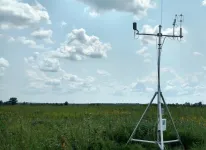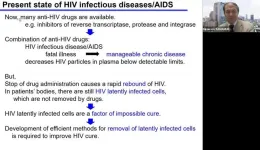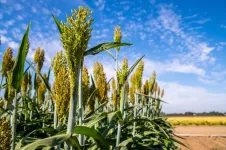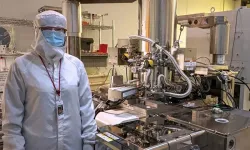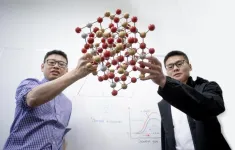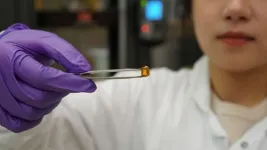(Press-News.org) One of the main reasons plants use water is to allow them to absorb carbon dioxide from the atmosphere. This means that, in plants, the water and carbon cycles are tightly linked. In a new study, researchers from the University of Missouri and the United States Department of Agriculture (USDA) used this foundational principle to identify sustainable farming practices aimed at helping staple crops like corn and soybeans thrive during extreme weather conditions that have become more common in the Midwest.
This study examined how farming practices affect crop resilience to climate change by examining water and carbon fluxes in three contrasting ecosystems: A business-as-usual tilled cropping system, an aspirational no-till cropping system with cover crops, and a native tallgrass prairie ecosystem.
“One of the big goals is what we call climate-smart agriculture, which can mean using crops to absorb carbon out of the air, but it also means trying to adopt farming practices that help farms adapt to the changing climate,” USDA research hydrologist Adam Schreiner-McGraw said. “As it gets hotter, plants get more stressed, and that means they often have lower yields. This research is focused on understanding adaptation and how to work toward more resilient agro-ecosystems.”
A comparison of rates of evapotranspiration — when water transfers from the land to the atmosphere— and carbon dioxide exchange revealed interesting patterns among ecosystems. In an analysis of data collected over the past four-year cycle, the native prairie ecosystem had higher rates of evapotranspiration than the tilled cropping system. In comparison, however, the prairie’s rate of evapotranspiration didn’t differ much from that of the no-till cropping system. Further, both cropping systems had higher amounts of plant growth (i.e., carbon uptake) than the native prairie.
From these findings, the tilled cropping site appears the most sensitive to environmental changes compared to the native prairie, which is most resilient to extreme weather, Schreiner-McGraw, who works in the USDA’s Cropping Systems and Water Quality Research Unit on MU’s campus, said. Moreover, because the no-till system has the most crop diversity, including corn, soybeans, wheat, and hay, it had the most variable rates of evapotranspiration. This phenomenon Schreiner-McGraw attributes to agricultural management strategies.
Understanding variable rates of evapotranspiration help scientists weigh if the ‘planned’ management has a bigger impact on the water and carbon budgets than the ‘unplanned’ weather variability, which can help with predictions for crop water and carbon uptake as extreme weather gets worse.
Another way to build environmental resistance is to plant a diversified rotation of crops over the long term, said Jeffrey Wood, an assistant professor in the MU School of Natural Resources. As climate fluctuations intensify — for Missouri, that’s warmer, wetter winters and drier summers with less frequent rain — understanding how best to support crop adaptation and which crops to plant at what times of the year has become increasingly necessary.
“The type of work we do lends itself to collaboration because we all share data in a community-based network,” Wood said, “People are always willing to share ideas, which makes it easy to work together and contribute to research that expands in scope from the problems one researcher might be working on locally to those another might face on a bigger scale.”
“Agriculture accentuates interannual variability in water fluxes but not carbon fluxes, relative to native prairie, in the U.S. Corn Belt” was published in Agriculture and Forest Meteorology. Co-authors include Megan E. Metz, John Sadler and Kenneth Sudduth. This research is a contribution from the Long-Term Agroecosystem Research (LTAR) network, which is supported by the USDA.
END
New MU study examines variability of water, carbon in Missouri agriculture ecosystems and future impact on crops
In a world with unpredictable climate patterns, learning best practices for ensuring staple crops like corn and soybeans can adapt to changes in weather is paramount.
2023-06-21
ELSE PRESS RELEASES FROM THIS DATE:
Welcoming two new journals to the PLOS portfolio: PLOS Mental Health and PLOS Complex Systems
2023-06-21
SAN FRANCISCO — PLOS today is announcing that it will soon launch two new journals: PLOS Mental Health and PLOS Complex Systems. PLOS sees these new journals as an opportunity to give evolving research communities opportunities to forge a new path for research in the field. Whether that means welcoming new ways of sharing research transparently or cementing new policies that enable research to be evaluated and rewarded more fairly, or simply finding a broader audience where research can make a greater real-world impact.
PLOS Mental Health provides a dedicated venue for all mental health research, connecting global experts from a broad range of disciplines and addressing challenges ...
A new, promising weapon in the fight against HIV
2023-06-21
A research team led by Tokyo Medical and Dental University (TMDU) has identified a molecular compound that activates latent HIV-1 in cells, showing promise for HIV treatments
Tokyo, Japan – A multi-institutional research group led by researchers from Tokyo Medical and Dental University (TMDU) has made a significant and promising step forward in our ability to treat human immunodeficiency virus type 1 (HIV-1), the virus underlying acquired immunodeficiency syndrome (AIDS).
To appreciate their accomplishment, we must first know a little about why HIV-1 is difficult to eliminate. ...
A roadmap for gene regulation in plants
2023-06-21
– By Will Ferguson
For the first time, researchers at the Department of Energy’s Lawrence Berkeley National Laboratory (Berkeley Lab) have developed a genome-scale way to map the regulatory role of transcription factors, proteins that play a key role in gene expression and determining a plant’s physiological traits. Their work reveals unprecedented insights into gene regulatory networks and identifies a new library of DNA parts that can be used to optimize genetic engineering efforts in plants.
“Transcription factors regulate things like how plants grow, how much fruit they produce, ...
Cave excavation pushes back the clock on early human migration to Laos
2023-06-21
CHAMPAIGN, Ill. — Fifteen years of archaeological work in the Tam Pa Ling cave in northeastern Laos has yielded a reliable chronology of early human occupation of the site, scientists report in the journal Nature Communications. The team’s excavations through the layers of sediments and bones that gradually washed into the cave and were left untouched for tens of thousands of years reveals that humans lived in the area for at least 70,000 years – and likely even longer.
“When we first started excavating the cave, we never expected to find humans in that region,” said University of Illinois Urbana-Champaign anthropology professor Laura Shackelford, who led ...
New microcomb device advances photonic technology
2023-06-21
A new tool for generating microwave signals could help propel advances in wireless communication, imaging, atomic clocks, and more.
Frequency combs are photonic devices that produce many equally spaced laser lines, each locked to a specific frequency to produce a comb-like structure. They can be used to generate high-frequency, stable microwave signals and scientists have been attempting to miniaturize the approach so they can be used on microchips.
Scientists have been limited in their abilities to tune these microcombs at a rate to make them effective. But a team of researchers ...
Now, every biologist can use machine learning
2023-06-21
By Lindsay Brownell
(BOSTON) — The amount of data generated by scientists today is massive, thanks to the falling costs of sequencing technology and the increasing amount of available computing power. But parsing through all that data to uncover useful information is like searching for a molecular needle in a haystack. Machine learning (ML) and other artificial intelligence (AI) tools can dramatically speed up the process of data analysis, but most ML tools are difficult for non-ML experts to access and use. Recently, automated machine learning (AutoML) methods have been developed that can automate the design and deployment ...
University of Toronto Engineering researchers are using electric fields to control the movement of defects in crystals
2023-06-21
An international team of researchers, led by University of Toronto Engineering Professor Yu Zou, is using electric fields to control the motion of material defects. This work has important implications for improving the properties and manufacturing processes of typically brittle ionic and covalent crystals, including semiconductors — a crystalline material that is a central component of electronic chips used for computers and other modern devices.
In a new study published in Nature Materials, researchers from ...
Assessment of a peer support group intervention for undocumented Latinx immigrants with kidney failure
2023-06-21
About The Study: This study of 23 undocumented immigrants with kidney failure receiving emergency dialysis found that a peer support group intervention achieved feasibility and acceptability. The findings suggest that a peer support group may be a patient-centered strategy to build camaraderie and provide emotional support in kidney failure, especially for socially marginalized uninsured populations who report limited English proficiency.
Authors: Lilia Cervantes, M.D., of the University of Colorado, Anschutz Medical Campus, in Aurora, is the corresponding author.
To ...
Biodegradable gel shows promise for cartilage regeneration
2023-06-21
A gel that combines both stiffness and toughness is a step forward in the bid to create biodegradable implants for joint injuries, according to new UBC research.
Mimicking articular cartilage, found in our knee and hip joints, is challenging. This cartilage is key to smooth joint movement, and damage to it can cause pain, reduce function, and lead to arthritis. One potential solution is to implant artificial scaffolds made of proteins that help the cartilage regenerate itself as the scaffold biodegrades. How well the cartilage regenerates is linked to how well a scaffold can mimic the biological properties of cartilage, and to date, researchers have struggled ...
New study in Nature Water demonstrates a vastly more sustainable, cost-effective method to desalinate industrial wastewater
2023-06-21
Vanderbilt researchers are part of a team that has developed a cutting-edge method that seeks to make the removal of salt from hypersaline industrial wastewater far more energy-efficient and cost-effective.
While desalination through reverse osmosis has made tremendous strides—allowing for salt removal from seawater for less than a penny per gallon—it still falls short in eliminating saline in wastewater from industries like mining, oil and gas and power generation and in inland brackish water. The industrial brines are currently injected into deep geological formations or transferred to a evaporation ponds, and both disposal methods are facing more regulatory and ...
LAST 30 PRESS RELEASES:
What determines the fate of a T cell?
Candida auris: genetic process revealed which could be treatment target for deadly fungal disease
Groundbreaking discovery turns household plastic recycling into anti-cancer medication
Blocking a key inflammatory pathway improves liver structure and vascular function in cirrhosis, study finds
Continuous spread: Raccoon roundworm detected in nine European countries
HKUST Engineering researchers developed a novel photodetector to enhance the performance of on-chip light monitoring
Strategic river sensors could have forewarned of Texas Camp flood disaster
Drone sampling of whale breath reveals first evidence of potentially deadly virus in Arctic
Roman soldiers defending Hadrian’s Wall infected by parasites, study finds
Pinochet’s prisoners were tormented with music but still found solace in it, a new book reveals
Fertility remains high in rural Tanzania despite access to family planning
AI-assisted device can improve autism care access
Kinetic careers
Uncovering how parasitic plants avoid attacking themselves to improve crop resistance
Nanoparticle vaccine strategy could protect against Ebola and other deadly filoviruses
Study finds brain care score can predict risk of stroke across racial groups
Key lung immune cells can intensify allergic reactions
Do hormones explain why women experience more gut pain?
New materials conduct ions in solids as easily as in liquids
Breakthrough of the Year: Renewable energy begins to eclipse fossil fuel-based sources
LLM use is reshaping scientific enterprise by increasing output, reducing quality and more
Introducing LightGen, a chip for ultra-fast, ultra-efficient generative AI
Astronomers see fireworks from violent collisions around nearby star
ACC/AHA issue new guideline on managing congenital heart disease in adults
Cosmic crash caught on camera
Is talented youth nurtured the wrong way? New study shows: top performers develop differently than assumed
Ants: An untapped resource in the development of antibiotics?
Archaeologists use AI to create prehistoric video game
Mitochondria migrate toward the cell membrane in response to high glucose levels
Tiny viral switch offers hope against drug-resistant bacteria
[Press-News.org] New MU study examines variability of water, carbon in Missouri agriculture ecosystems and future impact on cropsIn a world with unpredictable climate patterns, learning best practices for ensuring staple crops like corn and soybeans can adapt to changes in weather is paramount.
